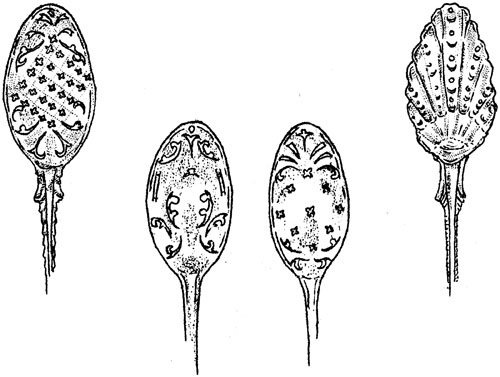|
Home : Quarterly Archives : Volume 3 |
Tredyffrin Easttown Historical Society |
|
Source: January 1940 Volume 3 Number 1, Pages 22–23 Spoons and a little spooning
I have been asked to write something about my old silver. Before I mention it, I am going to thumb over my notes and make a few remarks about antiques in general. What IS an antique? What is a curio, a relic? Do they all fall into the same class? Emphatically, no! An antique is primarily an object that was carefully made out of the best materials available and along good lines, in the beginning. It has stood the test of time, or it would not be a treasured piece in your cupboard, or on the shelf of some dealer today. A CURIO, on the other hand, though it may also stand the test of time, is an object that has a different appeal, something that may have only been made, or found, recently; some ingenious bit of carving, a fossil, or an interesting piece of mineral. A relic, as we all know, falls into a different category. Usually old, it has almost invariably some historical significance, and may like many curios, have no particular value other than sentimental. The collecting of any antique, curio or relic has one interest we must not lose sight of. One item in itself may not be important, but when a number have been acquired, the value of each piece in a group is at once enhanced. A few stamps, for instance, of an issue have but little meaning, but get the entire set, and you "have something." Several odd volumes in a series is unsatisfactory, but fill in the gaps and you have the complete whole. A number of years ago, I bought two English silver spoons at an antique show in New York, and though I did not know it at the time, I was off on the adventure of building up a nice collection of these fascinating pieces. I am chiefly interested in spoons made of silver, but should one go deeply into the subject of spoons, there are many other types to look for. Digging about in some magazine to cut up for my scrapbooks, I came across an advertisement of Old Welsh Love spoons made of wood with an illustration showing some with very old and curiously carved handles, made with devices, all of which had a special meaning. Several of them were double spoons on a single handle. These pieces were made by the amorous youth of a Wales now long past, and given as a token at the time of betrothal. On going deeper into the matter, I found that from this custom originated the word "spooning". Click goes my twenty-three year old typewriter. Quick for a five-cent stamp! By and by comes an interesting package--so that now, an old Welsh love spoon (a curio, rather than an antique) "sits" upon a crowded mantlepiece. I mentioned my scrapbooks, for why not pictures of spoons and photographs to study from when the originals are, for many reasons, unprocurable? I have had much pleasure from such books. To diverge again from what is a wandering discourse, let the student or seeker after knowledge not be mislead while in search for information in a museum. For there are two things to remember. Not every article labeled in a glass case, or arranged in some period room, is necessarily a "museum piece". Also in your own cupboard or on your library table there may be a rare bit of china, glass or old Sheffield that has been "lying around the house for years" unnoticed, taken for granted and in daily use, that is worthy of being carefully preserved and exhibited for the joy of future generations. For years now I have been gathering together what are called "mote or strainer" spoons. These charming little things were made to take the tea leaves or any mote or speck from the tea cup. Whereas the careful housewife of long ago might have quite a number of other spoons only one of these would be required in the set. This, coupled with their diminutive size, makes them scarce items today and many a dealer will shake his head when you ask for them. I am illustrating some of mine "life size" to show their beauty and delicacy of design. These spoons have two important points, among many, to consider in collecting. Up to now, their price, when procurable, has not been prohibitive and they are small and take up little space to display. Thus, they may be packed in a "hand size" box when taken around to exhibit, should the occasion demand. One parting shot and I am through. If you collect anything that is bought (and I regret not having done this in the beginning) make a record of it--where, when bought and the price given. This is important and will be valuable as time passes, and you add to the humble beginnings of what may, in the future, prove a worthwhile collection. |
